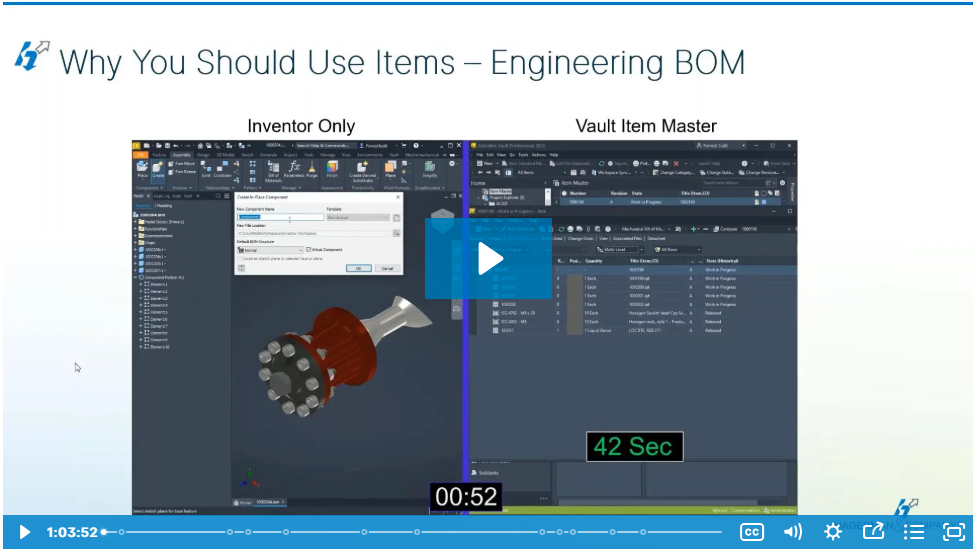Successful industrial manufacturing relies on a strong foundation of data management and organization.
In many ways, data is a form of currency – fueling innovation and driving progress. According to the Harvard Business School, data-driven organizations are, “23 times more likely to outperform competitors in customer acquisition, nine times more likely to retain customers, and up to 19 times more profitable.”
The smartest and most successful industrial manufacturing organizations recognize the value of data – whether it’s CAD designs, product files, or other critical project management documentation. They take innovative approaches to document management, and look for any opportunity to streamline success.
However, as technology advances and the world spins on, legacy data systems can become cumbersome and outdated. Think about it another way: you’re not still using a typewriter, are you? Still, legacy data remains the backbone of industrial operation. Taking the typewriter analogy further, you no longer use a typewriter, but you still need to know the skill of typing.
Organizations must figure out how to move valuable information into new data systems to access it more efficiently – a concept not too dissimilar to how automation technology is helping bridge gaps in the manufacturing talent shortage.
At Hagerman, one of the areas we specialize in is Engineering Document Management (EDM), helping companies navigate the challenges and opportunities that legacy data migration presents. In this article, we break down three key strategies to help industrial manufacturers prepare for a successful legacy data migration.
Tip 1: Evaluate Current Legacy Data Systems
Like any project, before you kick off the process of legacy data migration, it’s essential to conduct an evaluation of your current systems. This evaluation serves as the foundation upon which your migration strategy will be built. It provides you with a clear understanding of your current data landscape. Keep the following points in mind:
- System Demonstrations: Begin by having your team demonstrate the current system in action. This step allows you to get insight into how your existing data management functions, the user interface, and the processes in place.
- Data Analysis: Take a deep dive into your data, helping you a full read on the details of the data you’re dealing with, and how it can create a seamless transition.
- Essential Data: Note the types of essential properties and metadata for a holistic look at the data. These details play a pivotal role in ensuring a smooth transition to a new system.
Tip 2: Audit Existing Data and System Dependencies
Do you have an understanding of your existing data and system dependencies? In order to ensure a smooth and successful migration, it’s important to take time to check through your existing situation. Plus, it’s an opportunity to evaluate if your organization needs an upgraded electronic document management system.
An audit also helps you maintain essential workflows and avoid disruptions. These are important actions for how to properly audit:
- Document: Request your team to document how the data and systems are currently interrelated and utilized in real-world scenarios. You’ll quickly understand dependencies and how different teams rely on different data sets.
- Screenshot Capture: Take screenshots! These are vital for recording the system in action, and the visual references can be referred to throughout the data migration process.
- Data Backups and Databases: Backups are pivotal for a reliable migration strategy, acting as a safety net to preserve your data integrity throughout the migration process.
Tip 3: Ensure Data Integrity During Migration
Data is almost currency, right? Obviously, that currency is no good if it’s destroyed or damaged. One of the foundational pillars to a successful legacy data migration is ensuring your data integrity is not damaged or lost during migration.
At Hagerman, we recognize the paramount importance of data integrity during migration. Our experienced team has experience working with many forms of legacy data, including:
- Windows files and folders
- File properties contained in the above files
- Existing older data management systems to be replaced
- Company ERP or other business systems
- Microsoft Excel spreadsheets
- Other in-house Access, SQL, Oracle or other databases
Further, we know how to import data to new systems through specific tools, both existing and customized for data migration. Some of our tools and services include (but are not limited to) the following:
- Modify legacy data to the specific format required for import into a new system
- Automated analysis and correction of broken CAD file relationships
- Tools to scan all customer-selected servers, PC’s and folders, and report all file data to a database for analysis. This facilitates file cleanup, merging, conversion, editing, renaming, deleting, and moving of files prior to import into a new system
- Tools that can batch update custom file properties based on spreadsheet data or folder hierarchies, enabling the powerful search capabilities of newer data management systems without weeks of manual data entry
The Top Post-Migration Challenges and Solutions
The duration of the migration process can vary depending on its complexity and scale. It could take a couple of weeks to a few months, but thorough planning and data integrity measures will ensure a smooth transition.
Once the data migration is complete, it’s common for manufacturing plants to face some challenges. But don’t worry, this is where Hagerman’s post-go-live support comes into play, such as the following actions:
- Additional Training: We offer additional training to help your team become proficient with the new system, answering questions as they arise.
- Issue Resolution: Our team provides support for troubleshooting and resolving any unexpected issues that may arise after the migration is complete.
- Fine-Tuning Systems: There’s value in feedback, and our experts take these opportunities to fine-tune systems to ensure optimal performance moving forward.
Want tutorials on how to boost your EDM efficiency?
Check out our free document management training webcast modules!
Are You Ready to Ensure a Smooth Legacy Data Migration?
Data migration is not simply a technical process. Instead, it should be viewed as a strategic business move that can propel your organization forward, helping you establish yourself as a leader in the field.
In other words, don’t be held back by the past but rather think of the future. How can you change what you’re doing today to be better tomorrow? Legacy data migration might seem intimidating or annoying, but tackling it now is a smart way to stay ahead.
At Hagerman, we offer expertise in Engineering Document Management and vow to make your legacy data migration journey a successful one. Our support doesn’t end with migration, as we help you and your team adjust to the new normal.
Contact us today and let’s build a better tomorrow, together.




Comments